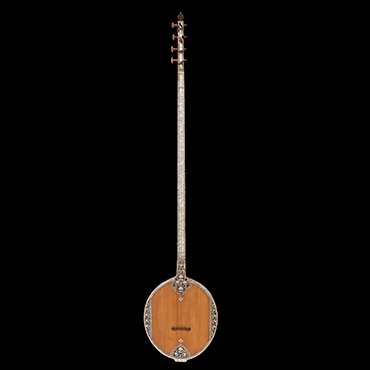The Al Thani Collection reflects the vision of His Highness Sheikh Hamad bin Abdullah Al Thani, its driving force, and features an extraordinary array of artworks spanning the ancient world to the present day. The collection is encyclopedic in its approach and represents a diverse range of cultures and civilizations, from Han Dynasty China, Olmec Mesoamerica, and Safavid Iran to Romanov Russia, the Pacific Islands, and the Arctic, celebrating creativity and the universal power of art through the ages. In Rabi‘ al-Awwal 1443 AH/November 2021 CE, the Centre des monuments nationaux—an agency of the Ministry of Culture of France —and The Al Thani Collection Foundation opened a museum space at the Hôtel de la Marine in Paris. The collection’s art from Islamic lands reflects the rich and diverse heritage of the Muslim world from the Umayyad Caliphate to the Mughal Empire, including manuscripts, miniatures, metalwork, textiles, hardstones, ceramics, glass, jewelry, and architectural elements.
The Al Thani Collection includes many superb examples of musical instruments. The group presented in AlMadar includes the oldest known tanbur, which dates to the first half of the 12th century AH/18th century CE. The precise definitions of pitch and measure in Islamic musical theory, celebrated since their codification by Al-Farabi in the 4th century AH/10th century CE, reflect the importance of stringed instruments and their ability to produce infinitely small variations of tone. The sophisticated mathematical elaboration of individual units (maqamat) in music is reflected in the decorative patterns on the instruments displayed in AlMadar.
Tanbur
The tanbur, a long-necked, plucked stringed instrument renowned for its deep, resonant sound, plays a significant role in classical Turkish music. Early Turkish music was rooted in a broader regional tradition based on Persian models, but by the late 11th century AH/17th century CE, Turkish music began to develop a unique identity, with the tanbur evolving alongside it. The instrument became a key component in this musical transformation, helping to shape the sound and style of the emerging Turkish musical tradition.
This tradition drew on the maqam system of Arabic music in which each maqam (meaning “place” or “location”) is defined by a specific scale and set of rules for melodic development. Each maqam encompasses a particular set of pitches, a characteristic melodic contour, and often emotional or spiritual connotations which provide a framework for composition and improvisation.
The Al Thani Collection tanbur is the oldest known example of its kind, dating back to the early 12th century AH/18th century CE. Its mother-of-pearl marquetry demonstrates remarkable artistry and harmonious symmetry. The hemispherical bowl is made of 11 plane tree or juniper heartwood ribs decorated with mother-of-pearl and tortoiseshell floral motifs. This motif extends along the outer ribs to the end of the upper bowl.
Türkiye, AH 1111–63/1700–50 CE
Plane tree, juniper, rosewood, walnut woods, ivory, bone, tortoise-shell, mother-of-pearl, buffalo horn, ebony
h. 139.5 × w. 30 × d. 20.5 cm
The Al Thani Collection, ATC648.1

